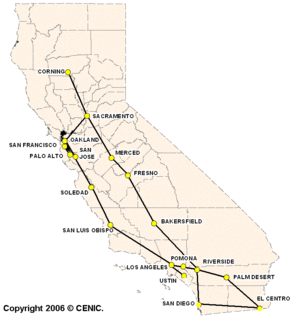- Corporation for Education Network Initiatives in California
-
 CENIC logo
CENIC logo
The Corporation for Education Network Initiatives in California (CENIC) is a nonprofit corporation formed in 1996 to provide high-performance, high-bandwidth networking services to California universities and research institutions. Through this corporation, representatives from all of California's K-20 public education combine their networking resources toward the operation, deployment, and maintenance of the California Research and Education Network, or CalREN.
Contents
Participants
Charter institutions which are connected to the CalREN backbone include:
- All 10 campuses of the University of California system and the UC Office of the President
- All 23 campuses of the California State University system and the CSU Chancellor's Office
- All 110 campuses of the California Community College system and many off-site centers
- All County Offices of Education in California's K-12 system and via those offices, over 8,000 K-12 schools
- Other universities including
- The California Institute of Technology
- Stanford University
- The University of Southern California
Other non-Charter participants include
- The Nevada System of Higher Education
- The University of Arizona
- Arizona State University
- The Naval Postgraduate School
- The NASA Ames Research Center
- The University of San Francisco
- The University of San Diego
- Pepperdine University
- National University
The California Research and Education Network
CalREN is a three-tiered network consisting of a statewide optical backbone to which schools and other institutions in California connect at Gigabit speeds via leased circuits obtained from telecom carriers or fiber-optic cable. These tiers include:
- CalREN-DC (Digital California): This tier includes services for all K-20 California research and education users. On completion of a major network refresh in 2008, the backbone speed for this tier is 10 Gbit/s.
- CalREN-HPR (High-Performance Research): This tier includes leading-edge services for large application users. Bandwidth speed for this tier is 10 Gbit/s. A major network refresh is planned to increase this to 40 Gbit/s.
- CalREN-XD (Experimental and Developmental): This tier includes bleeding-edge services for network researchers. This tier has no set maximum bandwidth.
All three network tiers operate independently.
Network peering
CENIC also engages in networking peering relationships, in particular Pacific Wave (a joint project between CENIC and the Pacific Northwest Gigapop, the University of Southern California, and the University of Washington), which provides peering facilities along the Pacific coast of the United States. Pacific Wave participants include networks in Australia, Canada, Japan, Korea, Qatar, Taiwan, Singapore, and the United States.
CENIC also engages in peering via TransitRail, a national-level peering structure that allows NLR members to leverage their membership in that organization to engage in peering relationships to cut costs and improve networking performance.
CENIC and Other National and International Networks
CalREN also connects at Gigabit speeds to Internet2, National LambdaRail, CUDI (the Corporación Universitaria para el Desarrollo de Internet), the Mexican high-bandwidth research and education network, redCLARA (the Cooperación Latino-Americana de Redes Avanzadas), and CAnet4 (the Canadian optical research and education network, managed by CANARIE).
CENIC is also a member of the Global Lambda Integrated Facility, an international organization promoting the use of worldwide optical networking to support grid computing.
CENIC and the K12 High Speed Network
CalREN was expanded by funding through the state of California and its Digital California Project to include K-12 public education. When funding sources changed, the K-12 portion became the K-12 High Speed Network (K12HSN), which continues to contract through CENIC.
External links
Categories:- Educational technology
- Academic computer network organizations
Wikimedia Foundation. 2010.

